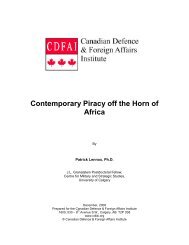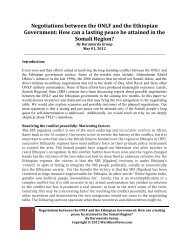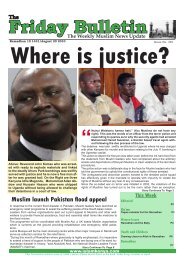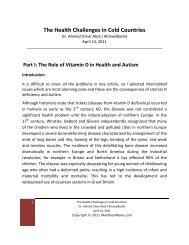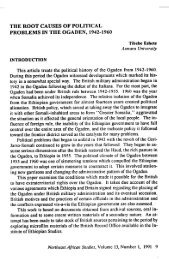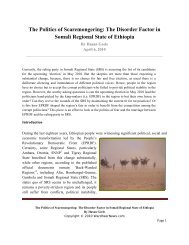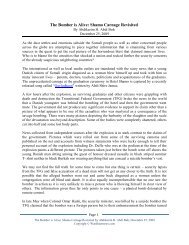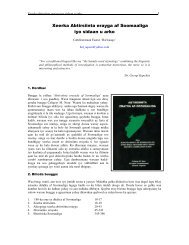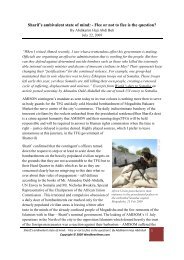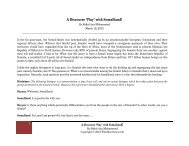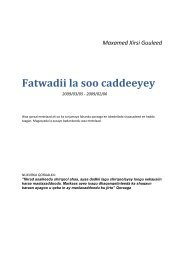View - WardheerNews
View - WardheerNews
View - WardheerNews
You also want an ePaper? Increase the reach of your titles
YUMPU automatically turns print PDFs into web optimized ePapers that Google loves.
INTRODUCTION 1<br />
The year 1991 marked a turning point for Somali nationalism in general and for Somali-<br />
Ethiopians 2 in particular. Resulting from the downfall of the Derg regime and the total<br />
disintegration of neighbouring Somalia, new institutions and political manoeuvres emerged<br />
within the Somali-inhabited territory of Ethiopia. The former Ogaden and today’s Somali<br />
Regional State (SRS) or Region 5 became one of nine member states within the<br />
decentralized, ethnically structured Ethiopian polity established under the Ethiopian<br />
People’s Revolutionary Democratic Front (EPRDF) (Aalen 2002; Pausewang et al. 2002). 3<br />
Ever since incorporation of the Ogaden into the Ethiopian Empire, politics in the Ethiopian<br />
Somali Region have been fashioned by the region’s double identity, first as a peripheral<br />
part of the Ethiopian nation-state and second as a division within the larger Somali political<br />
economy consisting of the former Somali Democratic Republic, Djibouti, north-east<br />
Kenya, and the Ethiopian Somali Region. The EPRDF’s granting of national selfdetermination<br />
to Somali-Ethiopians significantly altered political interactions between the<br />
Ethiopian highland and its Somali periphery. While it did not lead to effective pacification<br />
of the region, new political dynamics were unleashed.<br />
Young’s (1999:322) observation of how governments, development agencies, and<br />
political analysts ignored Ethiopia’s western regions of Gambella and Benishangul applies<br />
equally to the Somali Region. Due to a decades-long history of conflict and inaccessibility,<br />
the Somali Region is characterized by an astonishing data gap. Consequently, ‘the usual<br />
geographical and anthropological literature prevalent in other pastoral situations is lacking’<br />
(Abdi N. Umar 2004:4). Neglect of the region by Ethiopianists, Somali studies specialists,<br />
and other foreign scholars working on Ethiopian issues has been lamented before<br />
(Mohamud H. Khalif & Doornbos 2002:88). Chronic insecurity in large parts of the Somali<br />
Region - mainly due to fighting between the Ogaden National Liberation Front (ONLF)<br />
and the Ethiopian federal army as well as sporadic intrusions by armed groups from<br />
Somalia - have rendered data collection in the 250,000-km² wide territory an unpredictable<br />
and cumbersome undertaking. Apart from selected field reports by Ahmed Y. Farah (1995,<br />
1997), Hogg (1996, 1997), and van Brabant (1994) as well as short briefings by Markakis<br />
(1994, 1996), contributions on political developments in the Somali Region since 1991<br />
have been rare and meagre in empirical information. Many contributions focus on the pre-<br />
EPRDF period or have a rather general outlook on the region (for example, Brons et al.<br />
1995; Escher 1994; Mohamud H. Khalif & Doornbos 2002). Notable exceptions are<br />
2



